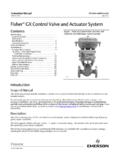Transcription of Inherent Factors Affecting Soil pH - USDA
1 Page 1 Guides for Educators soil pH is a measure of soil acidity or alkalinity. It is an important indicator of soil health. It affects crop yields, crop suitability, plant nutrient availability, and soil micro-organism activity which influence key soil processes. soil pH can be managed by measures such as applying the proper amount of nitrogen fertilizer, liming, and cropping practices that improve soil organic matter and overall soil health. Inherent Factors Affecting soil pH Inherent Factors Affecting soil pH such as climate, mineral content and soil texture cannot be changed. Natural soil pH reflects the combined effects of soil -forming Factors (parent material, time, relief or topography, climate, and organisms).
2 The pH of newly formed soils is determined by minerals in the soil s parent material. Temperature and rainfall control leaching intensity and soil mineral weathering. In warm, humid environments, soil pH decreases over time in a process called soil acidification, due to leaching from high amounts of rainfall. In dry climates, however, soil weathering and leaching are less intense and pH can be neutral or alkaline. Soils with high clay and organic matter content are more able to resist a drop or rise in pH (have a greater buffering capacity) than sandy soils. Although clay content cannot be modified, organic matter content can be changed by management.
3 Sandy soils commonly have low organic matter content, resulting in a low buffering capacity, high rates of water percolation and infiltration making them more vulnerable to acidification. soil pH Management soil pH is affected by land use and management. Vegetation type impacts soil pH. For example, areas of forestland tend to be more acidic than areas of grassland. Conversion of land from forestland or grassland to cropland can result in drastic pH changes after a few years. These changes are caused by a loss of organic matter, removal of soil minerals when crops are harvested, erosion of the surface layer, and effects of nitrogen and sulfur fertilizers.
4 Addition of nitrogen and sulfur fertilizers can lower soil pH over time. Measures that limit or correct acidification Liming to raise the pH of an acid soil Applying nitrogen and sulfur according to crop needs Apply N fertilizer in appropriate amounts, in a timely manner (relative to crop uptake) and use of good irrigation management to minimize nitrate-N leaching Diversified crop rotations to interrupt acidifying effects from N fertilizer application Applying irrigation water, manure, and other organic materials that have a high content of calcium or magnesium bicarbonates Page 2 Guides for Educators soil pH soil Quality Kit usda -NRCS Use of continuous no-till, cover crops, applications of solid manure, and diverse rotations with high-residue crops in order to increase organic matter content and improve soil buffering capacity to limit changes in pH.
5 Table 1. Crop yields relative to pH. Crop soil pH 5 Relative Yield (100 is the best, 0 is the worst) Corn 34 73 83 100 85 Wheat 68 78 89 100 99 Soybeans 65 79 80 100 93 Oats 77 93 99 98 100 Barley 0 23 80 95 100 Alfalfa 2 9 42 100 100 Timothy (grass) 31 47 66 100 95 Methods for Assessing soil Quality, page 173 (SSSA, 1996) Problems Related to pH and Relationship of pH to soil Function soil pH is an excellent indicator of a soil s suitability for plant growth. For most crops, a range of 6 to is best as shown in Table 1. soil pH levels that are too high or too low (Figure 1.) lead to deficiency of many nutrients, decline in microbial activity, decrease in crop yield, and deterioration of soil health.
6 For example, soil pH values below and between and limit availability of phosphate to plants (Figures 2 and 3). Four major management strategies to increase availability of phosphate to plants are: 1. Liming acid soils to increase soil pH to between and 2. Applying phosphorus fertilizer frequently in small amounts rather than one time in a large amount 3. Reducing contact between soil and phosphorus source (manure and/or fertilizer) by banding or injecting 4. Locating P-fertilizers near crop row where roots are most active Nitrogen cycling is inhibited by low pH. The effectiveness and degradation of herbicides and insecticides and solubility of heavy metals depend on pH.
7 Some diseases thrive when soil is alkaline or acidic. Effectiveness and potential carryover of certain soil -applied herbicides is also impacted by soil pH. Page 3 Guides for Educators soil pH soil Quality Kit usda -NRCS Figure 1. Relationship between plant nutrient availability and soil reaction (National soil Survey Manual, NRCS). Figure 2. Phosphorus availability relative to pH ranges (California Fertilizer Association, 1995). Figure 3. Image of corn with a phosphorus deficiency ( Croissant, ). What current practices do you think affect soil pH? _____ _____ _____ What impact do you expect these practices to have on soil pH and why?
8 _____ _____ _____ Page 4 Guides for Educators soil pH soil Quality Kit usda -NRCS Measuring soil pHMaterials Needed to Measure pH ____ Probe and plastic bucket for gathering and mixing soil samples ____ Roll of pH test strips ____ 1/8-cup ( ) measuring scoop ____ Calibrated 120-mL shaking vial with lid ____ Squirt bottle ____ Distilled water or rainwater ____ Pen, field notebook, sharpie, and zip-lock bags considerations Electical conductivity should always be measured before pH when using the same sample. soil phosphate, nitrate, and nitrite levels can be measured using the following steps. In-Field Quick Hand Test 1. soil Sampling: soil pH level is highly variable, depending on field location and time of year.
9 It is affected by fertilizer placement in rows or between rows, soil texture, organic matter content, and applications of manure or fertilizer. Using a soil probe gather at least 10 small samples randomly from an area that represents soil type and management history to a depth of 8 inches and place in a small plastic bucket. Do not include large stones and residue in sample. Repeat this step for each sampling area. 2. Neutralize hands by rubbing wet soil across palms (discard the soil ). 3. Place a scoop of mixed soil in your palm, and saturate soil with clean water (distilled water or rainwater).
10 4. Squeeze soil gently until a water slurry runs out of the cup of the hand and onto the side. 5. Touch the end of a 1-inch-long piece of pH test strip directly to slurry so that the tip is barely wet and solution can be drawn up the strip at least 1/4" to 1/2" beyond the area masked by soil (Figure 4). 6. Compare the color approximately 1/3 of the way up the colored portion of the strip to color chart on dispenser (Figure 5). Record soil pH and interpretations (Table 2). Figure 4. Quick hand test. Figure 5. soil pH color chart. Compare color 1/3 of the way up. Page 5 Guides for Educators soil pH soil Quality Kit usda -NRCS 1:1 soil -Water soil pH Test in Classroom 1.
















